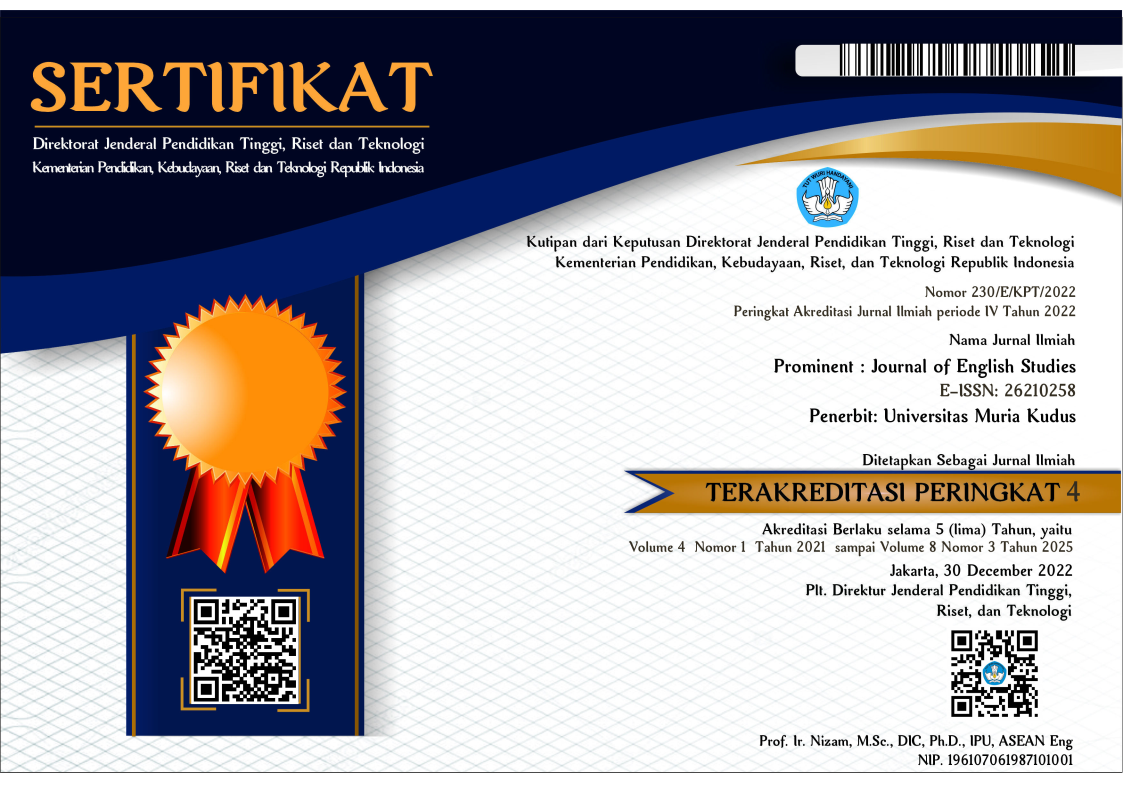SPONTANEITY ELEMENTS FOUND IN SPOKEN DISCOURSE OF UNIVERSITY STUDENTS
Abstract
Speaking English is useful to share information to other people around the world. To communicate appropriately, the students can fulfill the features of spontaneity. In fact, the students of Psychology Department of Muria Kudus University find difficulty to achieve the ideal situation. They do not know how to respond to the speaker spontaneously. To fill the empty space, the participants can apply spontaneity elements. The study is intended to analyze and explain the types of spontaneity elements found in the spoken discourse of university students and the university students’ understanding of spoken discourse. The design of the study used is discourse analysis. The participants were 16 students who did job interviews in pairs for 10 minutes. To collect the data is by using documentation. The findings showed that the types of spontaneity elements found in spoken discourse of university students are 176 occurrences consist of 45 repetitions (25.6%), 121 filled pauses (68.7%), 1 backtracking (0.6%), 9 incomplete utterances (5.1%). The students often use filled pauses to maintain the speaking consistency and seldom to use backchannels because they seldom to restatement the previous utterance while the students’ understanding of spoken discourse is low. It occurs because 3 elements of spontaneity are less than 50%, while 1 element is more than 50%. The students are actively speaking English only in the class. So, it is suggested for the students to speak English in daily life because by practicing to speak English, it can increase progress.
Keywords
Full Text:
PDFReferences
Afriani, R., Zainil, & Zaim, M. (2014). Filled Pauses used by The Students During The Students During The Discussions in Speaking Class of The English Department of STKIP PGRI SUMBAR. Journal English Language Teaching, 2(1), 27–37.
Aliyah, S. L., & Hestrian, R. A. P. (2021). An Analysis of Fillers used By Agnes Monica with Build Series’Interview. Curricula: Journal of Teaching and Learning, 6(2), 80–87. https://doi.org/10.22216/jcc.2021.v6i2.276
Alsaawi, A. (2019). Spoken and Written Language as Medium of Communication: A Self-reflection. International Journal of Applied Linguistics and English Literature, 8(2), 194–198. https://doi.org/10.7575/aiac.ijalel.v.8n.2p.194
Cornish, F. (2018). Understanding Spoken Discourse. Encyclopedia of Language & Linguistics, April, 1–7. https://doi.org/10.1016/b0-08-044854-2/04296-6
Derin, T., Putri, N. S., Nursafira, M. S., & Hamuddin, B. (2020). Discourse Analysis (DA) in the Context of English as a Foreign Language (EFL): A Chronological Review. Elsya : Journal of English Language Studies, 2(1), 1–8. https://doi.org/10.31849/elsya.v2i1.3611.
Dipta, D. (2019). Conversation Analysis as a Discourse Approach to Teaching Speaking Skill. JETLe (Journal of English Language Teaching and Learning), 1(1), 1–9. https://doi.org/10.18860/jetle.v1i1.7718
Gruenbaum, E. A. (2012). Common Literacy Struggles with College Students: Using the Reciprocal Teaching Technique. Journal of College Reading and Learning, 42(2), 110–116.
Jazadi, I. (2015). An Oral Discourse Perspective on Second Language Learning. IJEE (Indonesian Journal of English Education), 2(2), 132–144. https://doi.org/10.15408/ijee.v2i2.3092
Kalisa, P. (2013). Spoken Language Features Generated By Play Based Instructions. English Education Journal, 3(1), 20–26.
Koran, S. (2015). The Role of Teachers in Developing Learners’ Speaking Skill. 400–416.
Pamolango, V. A. (2016). An Analysis of the Fillers Used by Asian Students in Busan, South Korea: A Comparative Study. International Journal of Languages, Literature and Linguistics, 2(3), 96–99. https://doi.org/10.18178/ijlll.2016.2.3.74
Pardede, E. M., Saragih, A., & Pulungan, A. H. (2020). Types and functions of fillers used by Indonesian celebrities in seleb English Youtube videos. The 5th Annual International Seminar on Transformative Education and Educational Leadership (AISTEEL), 176–180. http://digilib.unimed.ac.id/41060/
Ramdani, J. M., & Rahmat. (2018). Promoting Speaking Spontaneity in Large Classes: An Action Research Study in An Indonesian EFL University Setting. Indonesian Journal of Applied Linguistics, 8(2), 388–401. https://doi.org/10.17509/ijal.v8i2.13304
Susanto, D. A., Oktavia, M., & Sembiring, L. T. A. B. (2021). Students’ Understanding on Spoken Discourse in The Context of English Language Teaching (ELT) at University. Eralingua: Jurnal Pendidikan Bahasa Asing Dan Sastra, 5(1), 265–274. https://doi.org/10.26858/eralingua.v5i1.18780
Syarifuddin, S., & Hasyim, I. (2019). A Review in Spoken Language Teaching. Jurnal, Bahasa, Sastra Dan Budaya Tamaddun Life, 18(1), 46–52. https://doi.org/10.33096/tamaddun.v18i1.28
Thornburry, S. (2012). Beyond the Sentence: Introducing Discourse Analysis. In Macmillan (Vol. 60, Issue 4). https://doi.org/10.1093/elt/ccl033
Wijayanti, D. N., & Fatmawati. (2019). The Appropriacy of Discourse Markers used in Psychology Department Students ’ Conversations. Jurnal Pendidikan Dan Kebudayaan Missio, 11(2), 279–292.
DOI: https://doi.org/10.24176/pro.v5i2.7587
Refbacks
- There are currently no refbacks.
Prominent Journal of English Studies is licensed under a Creative Commons Attribution-ShareAlike 4.0 International License.
Dedicated to:

in Collaboration with APSPBI:





